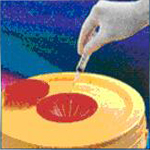The potential biological hazards in the clinical laboratory is prevented by the use of standard work practices, commonly referred to as universal precautions. all blood and certain other body fluids are cosidered potentially infectious for Hepatitis B virus, Hepatitis C virus, HIV and other blood born pathogens.
The body fluids that require the application of universal precautions are
-
- Blood
- semen
- vaginal fluid
- tissue (unfixed)
- synovial fluid
- Amniotic fluid
- Pleural Fluid
- Pericardial Fluid
- Peritonial Fluid
- CSF
- any fluid that blood stained
Universal precautions do not apply to following samples.
- faeces
- nasal secretions
- sputum
- sweat
- tears
- urine
- vomitus
- saliva (except the dental setting where the saliva is likely to be contaminated with blood)
The universal precautions should be applied to all body fluids when they are visibly contaminated with blood. Therefore barriers are used for protection against occupational exposure to blood and certain body fluids. These barriers consists of
- Personnel Protective Equipment (PPE)
- Engineering Control
- Work Practice Control
1. Personnel Protective Equipment (PPE)
This includes gloves, lab coats, gowns, shoe covers, goggles, glasses with shields, masks and resuscitation bags. The purpose of PPE is to prevent blood and body fluids from reaching the worker’s skin when exposing.
2. Engineering Control
This refers the methods of isolating or removing hazards from work place.
Examples
- sharp disposal container
- laser scalpel
- ventilated biological cabinets
3. Work Practice Control
This refers the practical techniques that reduce likelihood of exposure by changing the way a task is performed.
Examples
- Hand washing
- Handling of used needle and other sharps
- collecting and transporting fluids and tissues according to approved safe practices.

Well done
thanks
😀
Hai am a msc.nsg student. Your article is v.helping. And i am using it for my exam purpose..thank u
systematic information
r u medical personnel??